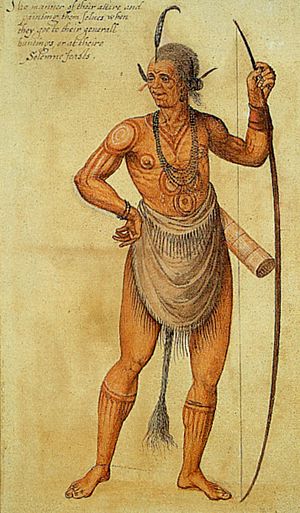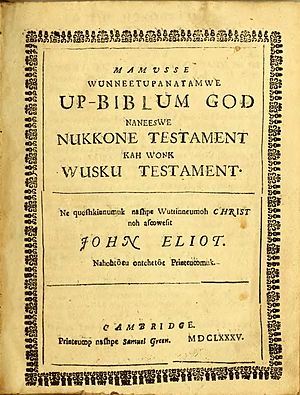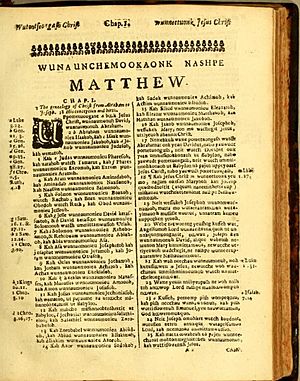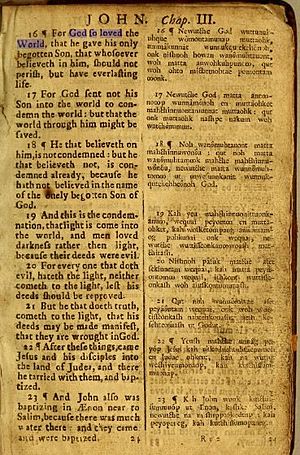Eliot Indian Bible facts for kids

Algonquian Indian Bible title page 1663
|
|
| Translator | John Eliot |
|---|---|
| Country | Colonial America |
| Language | Massachusett language |
| Subject | Bible |
| Genre | Christian literature |
| Publisher | Samuel Green |
|
Publication date
|
1663 |

The Eliot Indian Bible is a very special book. It was the first Christian Bible ever translated into a Native American language. It was also the first Bible printed in British North America. This amazing project was done by an English missionary named John Eliot. He translated the Bible into the Massachusett language.
The first part of the Bible, the New Testament, was printed in 1661. The full Bible, with all 66 books from both the Old and New Testaments, came out in 1663. The original title, Mamusse Wunneetupanatamwe Up Biblum God, means "The Whole Holy His-Bible God, both Old Testament and also New Testament. This turned by the servant of Christ, who is called John Eliot." A group called the Society for the Propagation of the Gospel in New England helped pay for this huge printing job.
Contents
How the Bible Was Made
Making the Eliot Indian Bible was a big deal. It involved three important things happening at the same time in history.
America's First Printing Press
In 1638, the very first printing press arrived in America. It was brought by Stephen Daye and Jose Glover. Sadly, Glover died on the trip. But his wife, Elizabeth Glover, and Daye set up the print shop in Cambridge, Massachusetts. This shop later became part of Harvard University Press. This press was used to print religious books, which was perfect for the Bible project.
Support from England
In 1649, the English Parliament passed a law. This law created a group called "The President and Society for the propagation of the Gospel in New England". This group, also known as the New England Company, collected money in England. This money was used to support missionary work in New England. A lot of this money went towards printing Eliot's Indian Bible.
John Eliot's Dedication
John Eliot came to the Massachusetts Bay Colony from England in 1631. He wanted to share Christianity with the Massachusett people. Eliot believed they would understand the Christian message better in their own language. So, he decided to translate the Bible into the Massachusett language.
Eliot spent over 14 years learning the Massachusett language. He even created a dictionary and grammar book for it. He got help from several local Massachusett Indians. These helpers included Cockenoe, John Sassamon, Job Nesuton, and James Printer.
In 1653, Eliot printed a small textbook in Massachusett. Then, in 1655-56, he printed parts of the Bible as a sample. The New England Company liked the sample. They sent a printer named Marmaduke Johnson to America in 1660. He brought paper and special printing letters. These extra letters were needed for the unique sounds of the Massachusett language.
In 1661, with Johnson's help and a Nipmuc man named James Printer, 1,500 copies of the New Testament were printed. By 1663, they finished printing 1,000 copies of the complete 66-book Bible. This huge book was 1,180 pages long. The money for all this came from donations in England and Wales.
The Bible's Impact
Eliot was determined to give the Massachusett people the Christian Bible in their own language. He learned the Natick dialect of Massachusett and its grammar. This allowed him to translate the Bible from a language that had no written form into a written alphabet. Now, the Algonquian Indians could read and understand it.
The translation helped answer questions the Natick Indians had. For example, they asked things like: "If but one parent believe, what state are our children in?" and "Can they in Heaven see us here on Earth?" After Eliot's translation, they had a Bible they could read for answers.
Lasting Legacy
In 1664, a special copy of the Bible was given to King Charles II. Later, many copies of the first edition (1663) were destroyed during a war in 1675-76. But in 1685, the New England Company decided to print a second edition. This second edition was finished in 1686. About 2,000 copies were printed.
The Eliot Indian Bible was the largest printing project in Colonial America during the 1600s. It was also special because it was the first time the entire Bible was translated into a language that the translator was still learning. Usually, scholars translated the Bible into their own native language.
Today, the Massachusett language used in Eliot's Bible is no longer spoken. So, most people cannot read this Bible anymore. However, it remains important as the first full Bible translated into a Native American language.
In 1709, a special version of the Algonquian Bible was made by Experience Mayhew. It had the Indian words in one column and English words in another. This was used to help teach Massachusett Indians to read the scriptures. This version, sometimes called The Massachuset Psalter, was based on Eliot's original work.
The second edition of Eliot's Indian Bible has also been very helpful. It was used by the Wôpanâak Language Reclamation Project. This project compared it to the King James Bible to help relearn the Wôpanâak (Wampanoag) language.





